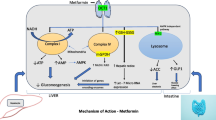Abstract
The disappearance rate (k) of i.v. glucose was measured in cachectic and non-cachectic cancer patients and tumour-free controls. The respective k values were found to be 1.06 +/- 0.27 (mean +/- s.d.), 1.64 +/- 0.34 and 1.63 +/- 0.23. Of the other parameters measured, only plasma albumin level was found to vary significantly amongst the 3 categories, the mean level being the lowest in cachectic cancer patients. The means of total plasma protein, fasting blood glucose and plasma liver enzyme concentrations were similar in the 3 groups. Glucagon, a potent insulin secretogogue, failed to augment the fasting insulin level in cachectic but did so in non-cachectic cancer patients. Taken together, the findings suggest that the reduced glucose tolerance in patients with neoplasia is due to impairment of insulin release exhibited predominantly by ill-nourished advanced cancer patients having a moderate to sever degree of hypoalbuminemia.
Similar content being viewed by others
Rights and permissions
About this article
Cite this article
Jasani, B., Donaldson, L., Ratcliffe, J. et al. Mechanism of impaired glucose tolerance in patients with neoplasia. Br J Cancer 38, 287–292 (1978). https://doi.org/10.1038/bjc.1978.200
Issue Date:
DOI: https://doi.org/10.1038/bjc.1978.200
- Springer Nature Limited
This article is cited by
-
Chronic Exendin-4 Treatment Prevents the Development of Cancer Cachexia Symptoms in Male Rats Bearing the Yoshida Sarcoma
Hormones and Cancer (2014)
-
The role of insulin resistance in the development of muscle wasting during cancer cachexia
Journal of Cachexia, Sarcopenia and Muscle (2012)




